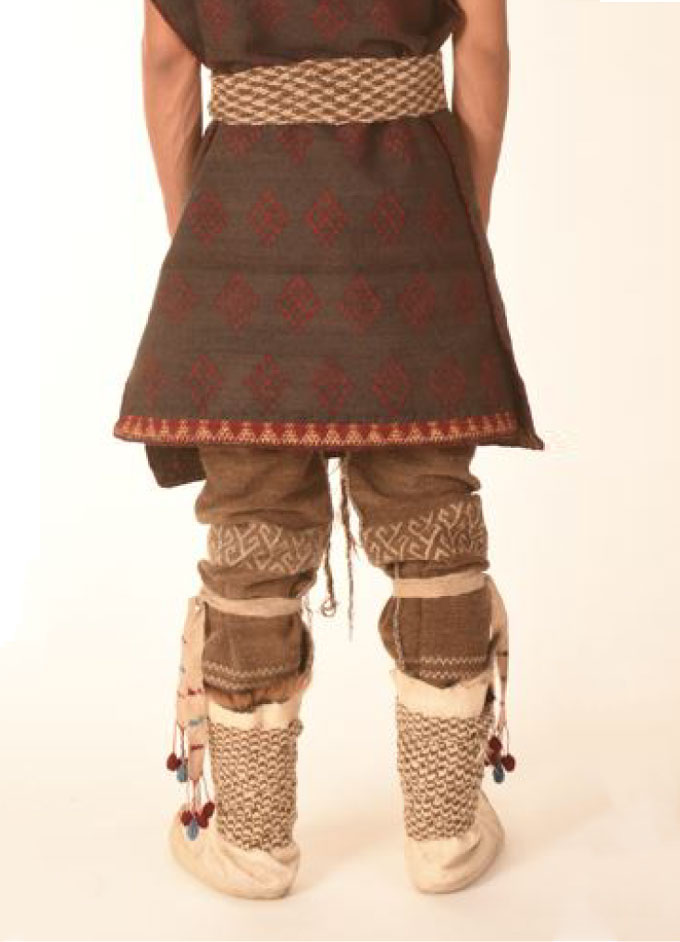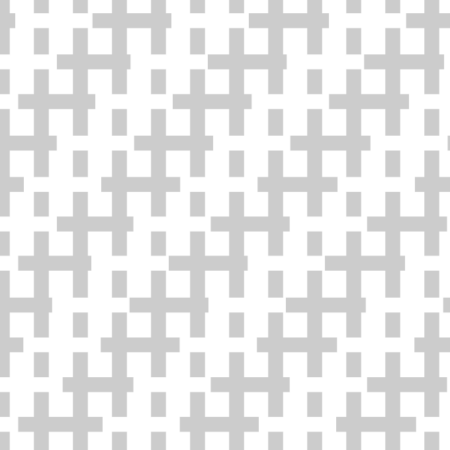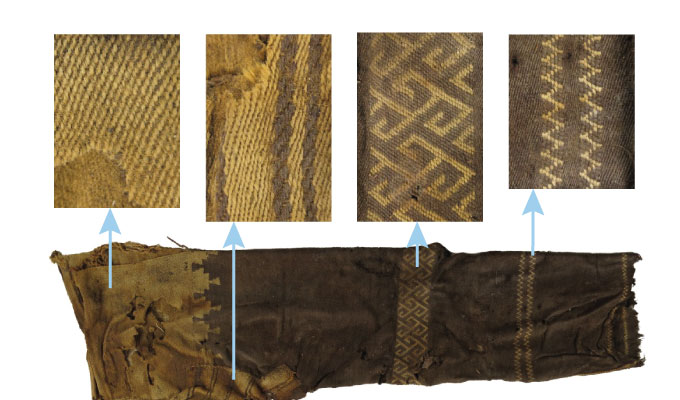What little rain that falls on a gravelly desert located in western China’s Tarim Basin evaporates as it hits the blistering turf. Here, in this parched wasteland, lie the ancient remains of people who made one of the biggest fashion splashes of all time.
Herders and horse riders who buried their dead in the Tarim Basin’s Yanghai graveyard pioneered pants making between roughly 3,200 and 3,000 years ago. Their deft combination of weaving techniques and decorative patterns — displaying influences from societies across Eurasia — yielded a pair of stylish yet durable trousers now recognized as the oldest such garment known in the world (SN: 5/30/14).
Now, an international team of archaeologists, fashion designers, geoscientists, chemists and conservators has untangled how those trousers were made and painstakingly created a modern replica. The vintage slacks weave a tale not only of textile innovation but also of how cultural practices fanned out across Asia, the researchers report in the March Archaeological Research in Asia.
“A diversity of textile techniques and patterns of different local origins, traditions and times merged into something new in this garment,” says archaeologist and project director Mayke Wagner of the German Archaeological Institute in Berlin. “Eastern Central Asia was a laboratory where people, plants, animals, knowledge and experiences from different directions and sources came … and were transformed.”
Fashion icon
One man brought the pants to scientists’ attention without uttering a word. His naturally mummified body, as well as the preserved bodies of more than 500 others, was uncovered during excavations conducted by Chinese archaeologists since the early 1970s at the Yanghai cemetery.
He sported an outfit that consisted of the trousers, a poncho belted at the waist, one pair of braided bands to fasten the trouser legs below the knees, another pair to fasten soft leather boots at the ankles and a wool headband with four bronze disks and two seashells sewn on it. A leather bridle, wooden horse bit and battle-ax that had been placed in his grave indicated he had been a horse-riding warrior.
 A woven reproduction of Turfan Man’s outfit, worn here by a model, includes a belted poncho, pants with braided leg fasteners and boots.M. Wagner et al/Archaeological Research in Asia 2022
A woven reproduction of Turfan Man’s outfit, worn here by a model, includes a belted poncho, pants with braided leg fasteners and boots.M. Wagner et al/Archaeological Research in Asia 2022
Researchers now call him Turfan Man because the Yanghai site lies about 43 kilometers southeast of the Chinese city of Turfan.
Of all of Turfan Man’s garments, his trousers stood out as truly special. Not only were they older by at least several centuries than any other examples of such gear, but the Yanghai pants also boasted a sophisticated, modern look. The pants feature two leg pieces that gradually widen at the top, connected by a crotch piece that widens and bunches in the middle to increase leg mobility.
Within a few hundred years, mobile groups across Eurasia began wearing pants like those at Yanghai, other archaeological finds have shown. Woven leg covers connected by a flexible crotch piece eased the strain of riding horses bareback over long distances. Not surprisingly, mounted armies debuted around that time.
Today, people everywhere don denim jeans and dress slacks that incorporate the design and production principles of the ancient Yanghai trousers.
In short, Turfan Man was the ultimate trendsetter.
Fancy pants
Despite being so fashion-forward, the ancient Yanghai horseman left researchers wondering how his remarkable pants had been made. No traces of cutting appeared on the fabric, so Wagner’s team suspected that the garment had been woven to fit its wearer.
Close examination of Turfan Man’s trousers revealed a combination of three weaving techniques, the scientists report in the new study. A re-created version of the find — fashioned by an expert weaver from the yarn of coarse-wooled sheep similar to those whose wool was used by ancient Yanghai weavers — confirmed that observation.
Much of the garment consists of twill weave, a major innovation in the history of textiles.
Twill changes the character of woven wool from firm to elastic, providing enough “give” to let a person move freely in a pair of tight-fitting pants. The fabric is created by using rods on a loom to weave a pattern of parallel, diagonal lines. Lengthwise warp threads are held in place so that a row of weft threads can be passed over and under them at regular intervals. The starting point of this weaving pattern shifts slightly to the right or left for each ensuing row so that a diagonal line forms.
 A twill weave like that used to make the oldest known pants in the world is illustrated here. Horizontal weft threads pass over one and under two or more vertical warp threads, shifting slightly on each row to produce a diagonal pattern (dark gray).T. Tibbitts
A twill weave like that used to make the oldest known pants in the world is illustrated here. Horizontal weft threads pass over one and under two or more vertical warp threads, shifting slightly on each row to produce a diagonal pattern (dark gray).T. Tibbitts
Variations in the number and color of weft threads in the twill weave on Turfan Man’s trousers were used to create pairs of brown stripes running up the off-white crotch piece, the researchers found.
Textile archaeologist Karina Grömer of the Natural History Museum Vienna says she recognized twill weave on Turfan Man’s trousers when she examined them around five years ago. Grömer had previously reported that pieces of woven fabric found in Austria’s Hallstatt salt mine, where such delicate textiles preserve well, displayed the oldest known twill weave. Radiocarbon dating places the Hallstatt textiles between around 3,500 and 3,200 years old — roughly 200 years before Turfan man sported his britches.
People in Europe and Central Asia may have independently invented twill weaving, says Grömer, who did not participate in the new study. But at the Yanghai site, weavers combined twill with other weaving techniques and innovative designs to create high-quality riding pants.
“This is not a beginner’s item,” Grömer says. “It’s like the Rolls-Royce of trousers.”
Consider the ancient trousers’ knee sections. A technique now known as tapestry weaving produced a thicker, more protective fabric at these joints, the researchers found. A third weaving method was used on the upper border of the pants to create a thick waistband.
Other features of the trousers involved an unusual twining method, in which two differently colored weft threads were twisted around each other by hand and laced through warp threads, creating a decorative, geometric pattern across the knees that resembles interlocking T’s leaning to the side. The same twining method produced zigzag stripes at the trousers’ ankles and calves.
Wagner’s team could find only a few historical examples of such twining, including borders on cloaks of the Maori people, an Indigenous group in New Zealand.
Yanghai artisans also showed their ingenuity in designing a formfitting crotch piece that was wider at its center than at its ends, Grömer says. Trousers dating to a few hundred years later than the Yanghai find, found in several parts of Asia, often consist of woven legs connected by square fabric crotch pieces that resulted in a less comfortable and flexible fit. In tests with a man riding a horse bareback while wearing a re-created version of Turfan Man’s entire outfit, the trousers fit snugly yet allowed the legs to clamp firmly around the horse.
Today’s denim jeans are made from one piece of twill material following some of the same design principles as those favored by Yanghai pants makers three millennia ago.
 Ancient trousers (partly shown at bottom) from China’s Tarim Basin display twill weaving that was used to produce alternating brown and off-white diagonal lines at the tops of the legs (far left) and dark brown stripes on the crotch piece (second from left). Another technique for manipulating threads enabled artisans to create a geometric pattern at the knees (second from right) and zigzag stripes at the ankles (far right).M. Wagner et al/Archaeological Research in Asia 2022
Ancient trousers (partly shown at bottom) from China’s Tarim Basin display twill weaving that was used to produce alternating brown and off-white diagonal lines at the tops of the legs (far left) and dark brown stripes on the crotch piece (second from left). Another technique for manipulating threads enabled artisans to create a geometric pattern at the knees (second from right) and zigzag stripes at the ankles (far right).M. Wagner et al/Archaeological Research in Asia 2022
Clothes connections
Perhaps most striking, Turfan Man’s trousers tell a story of how ancient herding groups carried their cultural practices and knowledge across Asia, spreading seeds of innovation.
For instance, the interlocking T pattern decorating the ancient horseman’s pants at the knees appears on bronze vessels found in what’s now China from around the same time, roughly 3,300 years ago, Wagner’s team says. The nearly simultaneous adoption of this geometric form in Central and East Asia coincides with the arrival in those regions of herders from West Eurasian grasslands riding horses that they domesticated 4,200 years ago or more (SN: 10/20/21).
Pottery found at those horse riders’ home sites in western Siberia and Kazakhstan displays interlocking T’s as well. Any deeper meaning this pattern held aside from its artistic appeal remains unknown. But West Eurasian horse breeders probably spread the interlocking T design across much of ancient Asia, Wagner and her colleagues suspect.
Similarly, a stepped pyramid pattern woven into the Yanghai pants appears on pottery from Central Asia’s Petrovka culture, which dates to between around 3,900 and 3,750 years ago. The same pattern resembles architectural designs that are more than 4,000 years old from western and southwestern Asian and Middle Eastern societies, including Mesopotamian stepped pyramids, the researchers say. Tapestry weaving such as that observed on Turfan Man’s trousers also originated in those societies.
It’s no surprise that cultural influences from throughout Asia affected ancient people in the Tarim Basin, says anthropologist Michael Frachetti of Washington University in St. Louis. Yanghai people inhabited a region at a crossroads of seasonal migration routes followed by herding groups starting more than 4,000 years ago (SN: 3/8/17). Those routes ran from the Altai Mountains in Central and East Asia to Southwest Asia where Iran is located today. Excavations at sites along those routes indicate that herders spread crops across much of Asia too (SN: 4/2/14).
Cultural transitions in the Tarim Basin may have started even earlier. Ancient DNA suggests that western Asian herders in oxen-pulled wagons moved through much of Europe and Asia around 5,000 years ago (SN: 11/15/17).
By around 2,000 years ago, herders’ migration paths formed part of a trade and travel network running from China to Europe that became known as the Silk Road. Cultural mixing and mingling intensified as thousands of local routes throughout Eurasia formed a massive network.
Turfan Man’s multicultural riding pants show that even in the Silk Road’s early stages, migrating herders carried new ideas and practices to distant communities. “The Yanghai pants are an entry point for examining how the Silk Road transformed the world,” Frachetti says.

Sign Up For the Latest from Science News
Headlines and summaries of the latest Science News articles, delivered to your inbox
Client key* E-mail Address* Go
Thank you for signing up!
There was a problem signing you up.
Looming questions
A more basic question concerns how exactly Yanghai clothes makers transformed yarn spun from sheep’s wool into Turfan Man’s trousers. Even after making a replica of those pants on a modern loom, Wagner’s team is unsure what an ancient Yanghai loom looked like. No remnants of those devices have been found.
The researchers suspect a loom constructed to be operated from a sitting position would have made it possible to create intricate, twined patterns. Experiments with different weaving devices are the next step in untangling how Turfan Man’s trousers were made, Wagner says.
It’s clear, though, that the makers of these ancient pants blended several complex techniques into a revolutionary piece of apparel, says archaeologist and linguist Elizabeth Barber of Occidental College in Los Angeles. Barber has studied the origins and development of cloth and clothing in West Asia.
“We truly know so little about how clever the ancient weavers were,” Barber says.
Turfan Man may not have had time to ponder his clothes makers’ prowess. With a pair of pants like that, he was ready to ride.

